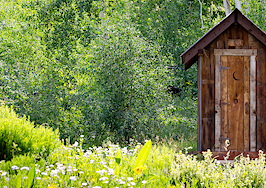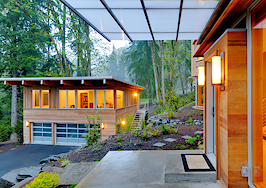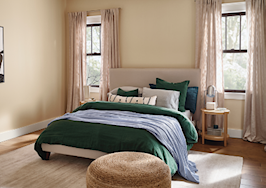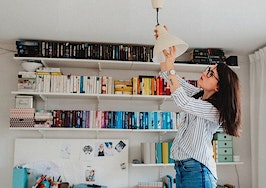After years of obsession with creamy, neutral-toned walls, homeowners are gravitating toward bright, bold wallpapers to liven up their spaces. Botanical prints, graphic illustrations, heritage designs, and murals have become crowd favorites for weekend warriors who have plenty of patience and an HGTV tutorial in hand.
“Wallpaper is a key trend for 2020, and the insatiable appetite from consumers doesn’t look like it’s abating any time soon,” Andrew Martin Design Director David Harris told Homes and Gardens. “Whatever your taste, there is something for everyone, from traditional florals and trompe l’oeil to contemporary geometric and tropical patterns or animal motifs and architectural designs.”
“The progress in new printing techniques and finishes is constantly pushing the boundaries, and the availability of new substrates makes it even more exciting,” Harris added. “Gone are the days of just printing on paper; you can now embellish corks, grass-cloths, and silks with pretty much any design.
He continued, “The usage is also bolder and braver. If you have confidence, there are endless possibilities.”
However, with “endless possibilities” comes the opportunity for epic failure in the form of misaligned wallpaper, peeling or bubbling wallpaper in damp spaces, or just a downright unsightly design. Here are some of the top wallpaper fails to show enterprising buyers or sellers before they make a design gaffe of a lifetime.
1. I needed what?!

This DIY designer forgot to place lining paper over their burgundy walls before applying a white, flower print wallpaper. Wallpaper expert CA Smith told Livingetc that homeowners should use lining paper no matter what color their wall is since it helps the wallpaper securely adhere to the wall. It also ensures a relatively easy removal if you decide the wallpaper doesn’t fit your style.
“I would almost always recommend using lining paper; it gives you a perfect base on which to hang wallpaper,” Smith said. “Put simply, sticking paper to paper works, but sticking paper to paint or plaster might not.”
“Lining paper is also an extra layer of protection to ensure paint doesn’t come off and makes it a lot easier to apply, remove, replace, and paint over later, as it protects the wall from damage by preparing it for appropriate paste absorption,” he added.
2. Almost doesn’t count

This enterprising homeowner got too excited about her jacquard wallpaper and forgot to measure her walls properly. According to her Instagram, she was able to find matching wallpaper nearly two months later — quite a long time to look at a bare patch on an otherwise stunning wall. To avoid this issue, Steve’s Blinds and Wallpaper provided a relatively easy-to-follow diagram on how to measure your wall and properly account for any wonky angles or bends.
Steve said homeowners need to calculate the wallpaper’s combined width, which is a fancy way of saying you need to measure every wall you plan to wallpaper. Then, you must measure the wall length and wallpaper pattern and repeat.
“Multiply the combined width by the height of the walls – this is the total square footage (TSF) of wall space you need to cover with wallpaper,” the tutorial read. “To keep things simple and to ensure you have enough paper, do not make any deductions for windows, doors, cabinets, etc.”
“The final step is to factor in the pattern repeat,” it added. “If the pattern repeat is 18″ or less, then divide the TSF by 23, if the pattern repeat is 19″ to 25″ then divide the TSF by 20.”
Finally, “This final number is the total number of single rolls of wallcovering that is required for your project. If the pattern does not repeat (random match), then use the [first] TSF [calculation] from above.”
3. Don’t put wallpaper on the toilet

This seems like a no-brainer, but it’s an atrocious idea to wallpaper a toilet seat. In addition to the outdated print, designer Haylie Lapinskas told realtor.com it poses a health threat.
“Talk about a cleaning issue,” Lapinskas said. “Would not want to know how grimy the back of that toilet is.”
“In all seriousness, one should never install a wall covering on a toilet,” she added. “There are condensation issues and cleaning issues. I give this one a month before it starts to peel up and mold.”
Beyond a wallpapered toilet, installing wallpaper in a bathroom is difficult due to the amount of humidity and moisture. Design expert Coral Nafie told The Spruce that homeowners should use splashproof wallpaper to ensure their design’s longevity.
“Even with the greatly improved wallpaper adhesives available on wall coverings today, the conditions that exist in every bathroom can have an effect on the adhesive over time,” Nafie explained. “If you do choose to wallpaper your whole bathroom, or especially the area by the sink and tub, opt for ‘splashproof’ wallpaper.”
“This type of wallpaper is specifically designed for high humidity areas and is even wipeable, should anything get on it,” she added. “[However,] if your bathroom is well-ventilated and doesn’t get very humid, standard wallpaper should work fine in your space.”
4. Beware paintable wallpaper

At first, paintable wallpaper sounds like a relatively great idea — you choose the perfect pattern and let your creativity flow with a custom colorway. However, as this homeowner’s Instagram post shows, installing and painting paintable wallpaper is much harder than it looks.
Resene Colour Consultant Sarah Gregory told NewsHub New Zealand paintable wallpaper is actually a great option for homeowners with cracked or hole-ridden walls. The wallpaper’s texture easily covers those imperfections, she said, and cuts time on wall repair time.
“Textured wallpaper is a good option if your walls aren’t up to a paint finish,” she said. “There is a range of textures, including floral, striped, and antique-look patterns.”
“You don’t need to spend hours sanding and priming, just apply wallpaper, then paint over it in your favorite color, she added.
Gregory said the key to painting textured wallpaper is choosing a waterborne paint, which contains a lower level of solvents than regular interior paint. Benjamin Moore and BEHR produce waterborne paints that give a lacquered or enameled look to paintable wallpaper.
5. Placement is everything

Placement is everything, as evidenced by this adorable geography wallpaper that started as an ode to North America and morphed into something completely different. This mistake goes back to the aforementioned point about properly measuring walls and patterns, so you don’t end up with “No America” on your wall.
“Wallpapers with messages are especially interesting when messages are lost due to improper placement,” Homewares Insider Bryan Stoddard told realtor.com of the mistake. “This example is witty, but also instructive: Leave the installation to experts in order to avoid such gaffes.”
Homeowners can attempt to fix the wallpaper on their own, which requires them to cut out the misaligned part (in this case, North America), locate or buy another piece of identical wallpaper and move it over to maintain the integrity of the print. With that in mind, Stoddard has the best idea — leave it to the professionals.












